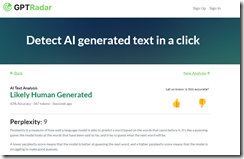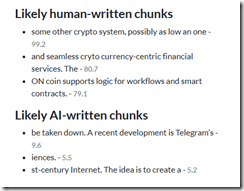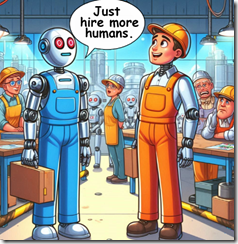Spotting Machine-Generated Content: A Work in Progress
July 31, 2024
 This essay is the work of a dinobaby. Unlike some folks, no smart software improved my native ineptness.
This essay is the work of a dinobaby. Unlike some folks, no smart software improved my native ineptness.
Some professionals want to figure out if a chunk of content is real, fabricated, or fake. In my experience, making that determination is difficult. For those who want to experiment with identifying weaponized, generated, or AI-assisted content, you may want to review the tools described in “AI Tools to Detect Disinformation – A Selection for Reporters and Fact-Checkers.” The article groups tools into categories. For example, there are utilities for text, images, video, and five bonus tools. There is a suggestion to address the bot problem. The write up is intended for “journalists,” a category which I find increasingly difficult to define.
The big question is, of course, do these systems work? I tried to test the tool from FactiSearch and the link 404ed. The service is available, but a bit of clicking is involved. I tried the Exorde tool and was greeted with the register for a free trial.
I plugged some machine-generated text produced with the You.com “Genius” LLM system in to GPT Radar (not in the cited article’s list by the way). That system happily reported that the sample copy was written by a human.
The test content was not. I plugged some text I wrote and the system reported:
Three items in my own writing were identified as text written by a large language model. I don’t know whether to be flattered or horrified.
The bottom line is that systems designed to identify machine-generated content are a work in progress. My view is that as soon as a bright your spark rolls out a new detection system, the LLM output become better. So a cat-and-mouse game ensues.
Stephen E Arnold, July 31, 2024
No Llama 3 for EU
July 31, 2024
Frustrated with European regulators, Meta is ready to take its AI ball and go home. Axios reveals, “Scoop: Meta Won’t Offer Future Multimodal AI Models in EU.” Reporter Ina Fried writes:
“Meta will withhold its next multimodal AI model — and future ones — from customers in the European Union because of what it says is a lack of clarity from regulators there, Axios has learned. Why it matters: The move sets up a showdown between Meta and EU regulators and highlights a growing willingness among U.S. tech giants to withhold products from European customers. State of play: ’We will release a multimodal Llama model over the coming months, but not in the EU due to the unpredictable nature of the European regulatory environment,’ Meta said in a statement to Axios.”
So there. And Meta is not the only firm petulant in the face of privacy regulations. Apple recently made a similar declaration. So governments may not be able to regulate AI, but AI outfits can try to regulate governments. Seems legit. The EU’s stance is that Llama 3 may not feed on European users’ Facebook and Instagram posts. Does Meta hope FOMO will make the EU back down? We learn:
“Meta plans to incorporate the new multimodal models, which are able to reason across video, audio, images and text, in a wide range of products, including smartphones and its Meta Ray-Ban smart glasses. Meta says its decision also means that European companies will not be able to use the multimodal models even though they are being released under an open license. It could also prevent companies outside of the EU from offering products and services in Europe that make use of the new multimodal models. The company is also planning to release a larger, text-only version of its Llama 3 model soon. That will be made available for customers and companies in the EU, Meta said.”
The company insists EU user data is crucial to be sure its European products accurately reflect the region’s terminology and culture. Sure That is almost a plausible excuse.
Cynthia Murrell, July 31, 2024
AI Reduces Productivity: Quick Another Study Needed Now
July 29, 2024
 This essay is the work of a dinobaby. Unlike some folks, no smart software improved my native ineptness.
This essay is the work of a dinobaby. Unlike some folks, no smart software improved my native ineptness.
At lunch one of those at my table said with confidence that OpenAI was going to lose billions in 2024. Another person said, “Meta has published an open source AI manifesto.” I said, “Please, pass the pepper.”
The AI marketing and PR generators are facing a new problem. More information about AI is giving me a headache. I want to read about the next big thing delivering Ford F-150s filled with currency to my door. Enough of this Debbie Downer talk.
Then I spotted this article in Forbes Magazine, the capitalist tool. “77% Of Employees Report AI Has Increased Workloads And Hampered Productivity, Study Finds.”
The write up should bring tears of joy to those who thought they would be replaced by one of the tech giants smart software concoctions. Human employees hallucinate too. But humans have a couple of notable downsides. First, they require care and feeding, vacations, educational benefits and/or constant retraining, and continuous injections of cash. Second, they get old and walk out the door with expertise when they retire or just quit. And, third, they protest and sometimes litigate. That means additional costs and maybe a financial penalty to the employer. Smart software, on the other hand, does not impose those costs. The work is okay, particularly for intense knowledge work like writing meaningless content for search engine optimization or flipping through thousands of pages of documents looking for a particular name or a factoid of perceived importance.
But this capitalist tool write up says:
Despite 96% of C-suite executives expecting AI to boost productivity, the study reveals that, 77% of employees using AI say it has added to their workload and created challenges in achieving the expected productivity gains. Not only is AI increasing the workloads of full-time employees, it’s hampering productivity and contributing to employee burnout.
Interesting. An Upwork wizard Kelly Monahan is quoted to provide a bit of context I assume:
“In order to reap the full productivity value of AI, leaders need to create an AI-enhanced work model,” Monahan continues. “This includes leveraging alternative talent pools that are AI-ready, co-creating measures of productivity with their workforces, and developing a deep understanding of and proficiency in implementing a skills-based approach to hiring and talent development. Only then will leaders be able to avoid the risk of losing critical workers and advance their innovation agenda.”
The phrase “full productivity value” is fascinating. There’s a productivity payoff somewhere amidst the zeros and ones in the digital Augean Stable. There must be a pony in there?
What’s the fix? Well, it is not AI because the un-productive or intentionally non-productive human who must figure out how to make smart software pirouette can get trained up in AI and embrace any AI consultant who shows up to explain the ropes.
But the article is different from the hyperbolic excitement of those in the Red Alert world and the sweaty foreheads at AI pitch meetings. AI does not speed up. AI slows down. Slowing down means higher costs. AI is supposed to reduce costs. I am confused.
Net net: AI is coming productive or not. When someone perceives a technology will reduce costs, install that software. The outputs will be good enough. One hopes.
Stephen E Arnold, July 29, 2024
Prompt Tips and Query Refinements
July 29, 2024
Generative AI is paving the way for more automation, smarter decisions, and (possibly) an easier world. AI is still pretty stupid, however, and it needs to be hand fed information to make it work well. Dr. Lance B. Eliot is an AI expert and he contributed, “The Best Engineering Techniques For Getting The Most Out Of Generative AI” for Forbes.
Eliot explains the prompt engineering is the best way to make generative AI. He developed a list of how to write prompts and related skills. The list is designed to be a quick, easy tutorial that is also equipped with links for more information related to the prompt. Eliot’s first tip is to keep the prompt simple, direct, and obvious, otherwise the AI will misunderstand your intent.
He the rattles of a bunch of rhetoric that reads like it was written by generative AI. Maybe it was? In short, it’s good to learn how to write prompts to prepare for the future. He runs through the list alphabetically, then if that’s enough Eliot lists the prompts numerically:
“I didn’t number them because I was worried that the numbering would imply a semblance of importance or priority. I wanted the above listing to seem that all the techniques are on an equal footing. None is more precious than any of the others.
Lamentably, not having numbers makes life harder when wanting to quickly refer to a particular prompt engineering technique. So, I am going to go ahead and show you the list again and this time include assigned numbers. The list will still be in alphabetical order. The numbering is purely for ease of reference and has no bearing on priority or importance.”
The list is rundown of psychological and intercommunication methods used by humans. A lot of big words are used, but the explanations were written by a tech-savvy expert for his fellow tech people. In layman’s terms, the list explains that anything technique will work. Here’s one from me: use generative AI to simplify the article. Here’s a paradox prompt: if you feed generative AI a prompt written by generative AI will it explode?
Whitney Grace, July 29, 2024
Why Is Anyone Surprised That AI Is Biased?
July 25, 2024
Let’s top this one last time, all right? Algorithms are biased against specific groups.
Why are they biased? They’re biased because the testing data sets contain limited information about diversity.
What types of diversity? There’s a range but it usually involves racism, sexism, and socioeconomic status.
How does this happen? It usually happens, not because the designers are racist or whatever, but from blind ignorance. They don’t see outside their technology boxes so their focus is limited.
But they can be racist, sexist, etc? Yes, they’re human and have their personal prejudices. Those can be consciously or inadvertently programmed into a data set.
How can this be fixed? Get larger, cleaner data sets that are more reflective of actual populations.
Did you miss any minority groups? Unfortunately yes and it happens to be an oldie but a goodie: disabled folks. Stephen Downes writes that, “ChatGPT Shows Hiring Bias Against People With Disabilities.” Downes commented on an article from Futurity that describes how a doctoral student from the University of Washington studies on ChatGPT ranks resumes of abled vs. disabled people.
The test discovered when ChatGPT was asked to rank resumes, people with resumes that included references to a disability were ranked lower. This part is questionable because it doesn’t state the prompt given to ChatGPT. When the generative text AI was told to be less “ableist” and some of the “disabled” resumes ranked higher. The article then goes into a valid yet overplayed argument about diversity and inclusion. No solutions were provided.
Downes asked questions that also beg for solutions:
“This is a problem, obviously. But in assessing issues of this type, two additional questions need to be asked: first, how does the AI performance compare with human performance? After all, it is very likely the AI is drawing on actual human discrimination when it learns how to assess applications. And second, how much easier is it to correct the AI behaviour as compared to the human behaviour? This article doesn’t really consider the comparison with humans. But it does show the AI can be corrected. How about the human counterparts?”
Solutions? Anyone?
Whitney Grace, July 25, 2024
The French AI Service Aims for the Ultimate: Cheese, Yes. AI? Maybe
July 24, 2024
AI developments are dominating technology news. Nothing makes tech new headlines jump up the newsfeed faster than mergers or partnerships. The Next Web delivered when it shared news that, "Silo And Mistral Join Forces In Yet Another European AI Team-Up.” Europe is the home base for many AI players, including Silo and Astral. These companies are from Finland and France respectively and they decided to partner to design sovereign AI solutions.
Silo is already known for partnering with other companies and Mistral is another member to its growing roster of teammates. The collaboration between the the two focuses on the deployment and planning of AI into existing infrastructures:
The past couple of years have seen businesses scramble to implement AI, often even before they know how they are actually going to use it, for fear of being left behind. Without proper implementation and the correct solutions and models, the promises of efficiency gains and added value that artificial intelligence can offer an organization risk falling flat.
“Silo and Mistral say they will provide a joint offering for businesses, “merging the end-to-end AI capabilities of Silo AI with Mistral AI’s industry leading state-of-the-art AI models,” combining their expertise to meet an increasing demand for value-creating AI solutions.”
Silo focuses on digital sovereignty and has developed open source LLM for “low resource European languages.” Mistral designs generative AI that are open source for hobby designers and fancier versions for commercial ventures.
The partnership between the two companies plans to speed up AI adoption across Europe and equalize it by including more regional languages.
Whitney Grace, July 24, 2024
Automating to Reduce Staff: Money Talks, Employees? Yeah, Well
July 24, 2024
 This essay is the work of a dinobaby. Unlike some folks, no smart software improved my native ineptness.
This essay is the work of a dinobaby. Unlike some folks, no smart software improved my native ineptness.
Are you a developer who oversees a project? Are you one of those professionals who toiled to understand the true beauty of a PERT chart invented by a Type A blue-chip consulting firm I have heard? If so, you may sport these initials on your business card: PMP, PMI-RMP, PRINCE2, etc. I would suggest that Google is taking steps to eliminate your role. How do I know the death knell tolls for thee? Easy. I read “Google Brings AI Agent Platform Project Oscar Open Source.” The write up doesn’t come out and say, “Dev managers or project managers, find your future elsewhere, but the intent bubbles beneath the surface of the Google speak.
A 35-year-old executive gets the good news. As a project manager, he can now seek another information-mediating job at an indendent plumbing company, a local dry cleaner, or the outfit that repurposes basketball courts to pickleball courts. So many futures to find. Thanks, MSFT Copilot. That’s a pretty good Grim Reaper. The former PMP looks snappy too. Well, good enough.
The “Google Brings AI Agent Platform Project Oscar Open Source” real “news” story says:
Google has announced Project Oscar, a way for open-source development teams to use and build agents to manage software programs.
Say hi, to Project Oscar. The smart software is new, so expect it to morph, be killed, resurrected, and live a long fruitful life.
The write up continues:
“I truly believe that AI has the potential to transform the entire software development lifecycle in many positive ways,” Karthik Padmanabhan, lead Developer Relations at Google India, said in a blog post. “[We’re] sharing a sneak peek into AI agents we’re working on as part of our quest to make AI even more helpful and accessible to all developers.” Through Project Oscar, developers can create AI agents that function throughout the software development lifecycle. These agents can range from a developer agent to a planning agent, runtime agent, or support agent. The agents can interact through natural language, so users can give instructions to them without needing to redo any code.
Helpful? Seems like it. Will smart software reduce costs and allow for more “efficiency methods” to be implemented? Yep.
The article includes a statement from a Googler; to wit:
“We wondered if AI agents could help, not by writing code which we truly enjoy, but by reducing disruptions and toil,” Balahan said in a video released by Google. Go uses an AI agent developed through Project Oscar that takes issue reports and “enriches issue reports by reviewing this data or invoking development tools to surface the information that matters most.” The agent also interacts with whoever reports an issue to clarify anything, even if human maintainers are not online.
Where is Google headed with this “manage” software programs? A partial answer may be deduced from this write up from Linklemon. Its commercial “We Automate Workflows for Small to Medium (sic) Businesses.” The image below explains the business case clearly:
Those purple numbers are generated by chopping staff and making an existing system cheaper to operate. Translation: Find your future elsewhere, please.”
My hunch is that if the automation in Google India is “good enough,” the service will be tested in the US. Once that happens, Microsoft and other enterprise vendors will jump on the me-too express.
What’s that mean? Oh, heck, I don’t want to rerun that tired old “find your future elsewhere line,” but I will: Many professionals who intermediate information will here, “Great news, you now have the opportunity to find your future elsewhere.” Lucky folks, right, Google.
Stephen E Arnold, July 24, 2024
Modern Life: Advertising Is the Future
July 23, 2024
 This essay is the work of a dinobaby. Unlike some folks, no smart software improved my native ineptness.
This essay is the work of a dinobaby. Unlike some folks, no smart software improved my native ineptness.
What’s the future? I think most science fiction authors missed the memo from the future. Forget rocket ships, aliens, and light sabers. Think advertising. How do I know that ads will be the dominant feature of messaging? I read “French AI Startup Launches First LLM Built Exclusively for Advertising Copy.”
Advertising professionals consult the book about trust and ethical behavior. Both are baffled at the concepts. Thanks, MSFT Copilot. You are an expert in trust and ethical behavior, right?
Yep, advertising arrives with smart manipulation, psycho-metric manipulative content, and shaped data. The write up explains:
French startup AdCreative.ai has launched a new large language model build exclusively for advertising. Named AdLLM Spark, the system was built to craft ad text with high conversion rates on every major advertising platform. AdCreative.ai said the LLM combines two unique features: instant text generation and accurate performance prediction.
Let’s assume those French wizards have successfully applied probabilistic text generation to probabilistic behavior manipulation. Every message can be crafted by smart software to work. If an output does not work, just fiddle around until you hit the highest performing payload for the doom scrolling human.
The first part of the evolution of smart software pivoted on the training data. Forget that privacy hogging, copyright ignoring approach. Advertising copy is there to be used and recycled. The write up says:
The training data encompasses every text generated by AdCreative.ai for its 2,000,000 users. It includes information from eight leading advertising platforms: Facebook, Instagram, Google, YouTube, LinkedIn, Microsoft, Pinterest, and TikTok.
The second component involved tuning the large language model. I love the way “manipulation” and “move to action” becomes a dataset and metrics. If it works, that method will emerge from the analytic process. Do that, and clicks will result. Well, that’s the theory. But it is much easier to understand than making smart software ethical.
Does the system work? The write up offers this “proof”:
AdCreative.ai tested the impact on 10,000 real ad texts. According to the company, the system predicted their performance with over 90% accuracy. That’s 60% higher than ChatGPT and at least 70% higher than every other model on the market, the startup said.
Just for fun, let’s assume that the AdCreative system works and performs as “advertised.”
- No message can be accepted at face value. Every message from any source can be weaponized.
- Content about any topic — and I mean any — must be viewed as shaped and massaged to produce a result. Did you really want to buy that Chiquita banana?
- The implications of automating this type of content production begs for a system to identify something hot on a TikTok-type service, extract the words and phrases, and match those words with a bit of semantic expansion to what someone wants to pitch, promote, occur, and what not. The magic is that the volume of such messages is limited only by one’s machine resources.
Net net: The future of smart software is not solving problems for lawyers or finding a fix for Aunt Milli’s fatigue. The future is advertising, and AdCreative.ai is making the future more clear. Great work!
Stephen E Arnold, July 17, 2024
Bots Have Invaded The World…On The Internet
July 23, 2024
Robots…er…bots have taken over the world…at least the Internet…parts of it. The news from Techspot is shocking but when you think about it really isn’t: “Almost Half Of All Web Traffics Is Bots, And They Are Mostly Malicious In Nature.” Akamai is the largest cloud computing platform in the world. It recently released a report that 42% of web traffic is from bots and 65% of them are malicious.
Akamai said that most of the bots are scrapper bots designed to gather data. Scrapper bots collect content from Web sites. Some of them are used to form AI data sets while others are designed to steal information to be used in hacker, scams, and other bad acts. Commerce Web sites are negatively affected the most, because scrapper bots steal photos, prices, descriptions, and more. Bad actors then make fake Web sites imitating the real McCoy. They make money by from ads by ranking on Google and stealing traffic.
Bots are nasty little buggers even the most benign:
“Even non-malicious scraping bots can degrade a website’s performance, impact search engine metrics, and increase computing and hosting costs.
Companies now face increasingly sophisticated bots that use AI algorithms, headless browser technology, and other advanced solutions. These new threats require novel, more complex mitigation approaches beyond traditional methods. A robust firewall is now only the beginning of the numerous security measures needed by website owners today.”
Akamai should have dedicated part of their study to investigate the Dark Web. How many bots or law enforcement officials are visiting that shrinking part of the Net?
Whitney Grace, July 23, 2024
Thinking about AI Doom: Cheerful, Right?
July 22, 2024
 This essay is the work of a dumb humanoid. No smart software required.
This essay is the work of a dumb humanoid. No smart software required.
I am not much of a philosopher psychologist academic type. I am a dinobaby, and I have lived through a number of revolutions. I am not going to list the “next big things” that have roiled the world since I blundered into existence. I am changing my mind. I have memories of crouching in the hall at Oxon Hill Grade School in Maryland. We were practicing for the atomic bomb attack on Washington, DC. I think I was in the second grade. Exciting.
The AI powered robot want the future experts in hermeneutics to be more accepting of the technology. Looks like the robot is failing big time. Thanks, MSFT Copilot. Got those fixes deployed to the airlines yet?
Now another “atomic bomb” is doing the James Bond countdown: 009, 008, and then James cuts the wire at 007. The world was saved for another James Bond sequel. Wow, that was close.
I just read “Not Yet Panicking about AI? You Should Be – There’s Little Time Left to Rein It In.” The essay seems to be a trifle dark. Here’s a snippet I circled:
With technological means, we have accomplished what hermeneutics has long dreamed of: we have made language itself speak.
Thanks to Dr. Francis Chivers, one of my teachers at Duquesne University, I actually know a little bit about hermeneutics. May I share?
Hermeneutics is the theory and methodology of interpretation of words and writings. One should consider content in its historical, cultural, and linguistic context. The idea is to figure out the the underlying messages, intentions, and implications of texts doing academic gymnastics.
Now the killer statement:
Jacques Lacan was right; language is dark and obscene in its depths.
I presume you know well the work of Jacques Lacan. But if you have forgotten, the canny psychologist got himself kicked out of the International Psychoanalytic Association (no mean feat as I recall) for his ideas about desire. Think Freud on steroids.
The write up uses these everyday references to make the point:
If our governments summon the collective will, they are very strong. Something can still be done to rein in AI’s powers and protect life as we know it. But probably not for much longer.
Okay. AI is going to screw up the world. I think I have heard that assertion when my father told me about the computer lecture he attended at an accounting refresher class. That fear he manifested because he thought he would lose his job to a machine attracted me to the dark unknown of zeros and ones.
How did that turn out? He kept his job. I think mankind has muddled through the computer revolution, the space revolution, the wonder drug revolution, the automation revolution, yada yada.
News flash: The AI revolution has been around long before the whiz kids at Google disclosed Transformers. I think the author of this somewhat fearful write up is similar to my father’s projecting on computerized accounting his fear that he would be harmed by punched cards.
Take a deep breath. The sun will come up tomorrow morning. People who know about hermeneutics and Jacques Lacan will be able to ponder the nature of text and behavior. In short, worry less. Be less AI-phobic. The technology is here and it is not going away, getting under the thumb of any one government including China’s, and causing eternal darkness. Sorry to disappoint you.
Stephen E Arnold, July 22, 2024









